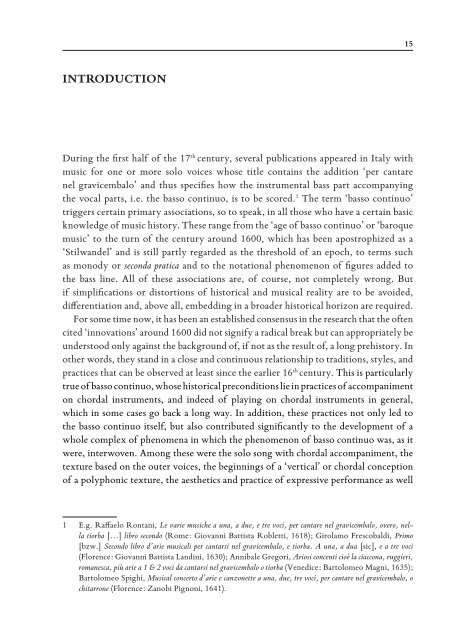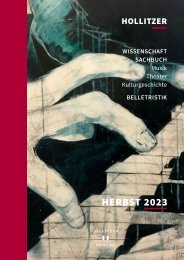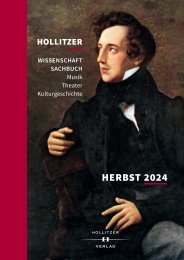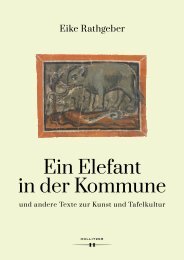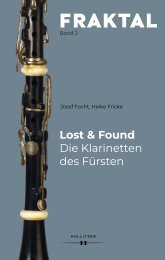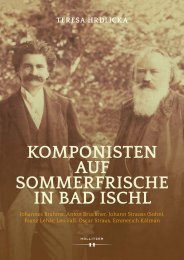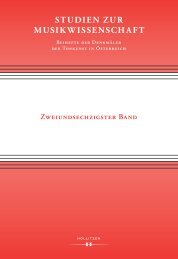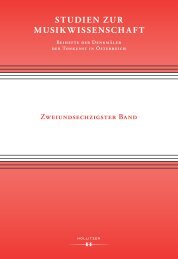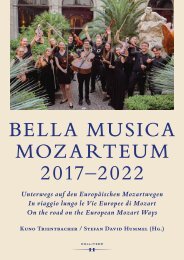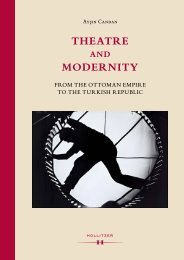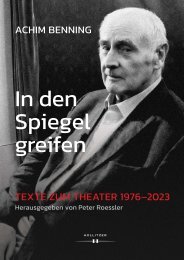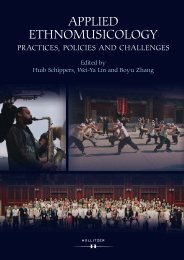Leseprobe_Anklaenge 2020-2021
Erfolgreiche ePaper selbst erstellen
Machen Sie aus Ihren PDF Publikationen ein blätterbares Flipbook mit unserer einzigartigen Google optimierten e-Paper Software.
15<br />
INTRODUCTION<br />
During the first half of the 17 th century, several publications appeared in Italy with<br />
music for one or more solo voices whose title contains the addition ‘per cantare<br />
nel gravicembalo’ and thus specifies how the instrumental bass part accompanying<br />
the vocal parts, i.e. the basso continuo, is to be scored. 1 The term ‘basso continuo’<br />
triggers certain primary associations, so to speak, in all those who have a certain basic<br />
knowledge of music history. These range from the ‘age of basso continuo’ or ‘baroque<br />
music’ to the turn of the century around 1600, which has been apostrophized as a<br />
‘Stilwandel’ and is still partly regarded as the threshold of an epoch, to terms such<br />
as monody or seconda pratica and to the notational phenomenon of figures added to<br />
the bass line. All of these associations are, of course, not completely wrong. But<br />
if simplifications or distortions of historical and musical reality are to be avoided,<br />
differentiation and, above all, embedding in a broader historical horizon are required.<br />
For some time now, it has been an established consensus in the research that the often<br />
cited ‘innovations’ around 1600 did not signify a radical break but can appropriately be<br />
understood only against the background of, if not as the result of, a long prehistory. In<br />
other words, they stand in a close and continuous relationship to traditions, styles, and<br />
practices that can be observed at least since the earlier 16 th century. This is particularly<br />
true of basso continuo, whose historical preconditions lie in practices of accompaniment<br />
on chordal instruments, and indeed of playing on chordal instruments in general,<br />
which in some cases go back a long way. In addition, these practices not only led to<br />
the basso continuo itself, but also contributed significantly to the development of a<br />
whole complex of phenomena in which the phenomenon of basso continuo was, as it<br />
were, interwoven. Among these were the solo song with chordal accompaniment, the<br />
texture based on the outer voices, the beginnings of a ‘vertical’ or chordal conception<br />
of a polyphonic texture, the aesthetics and practice of expressive performance as well<br />
1 E.g. Raffaelo Rontani, Le varie musiche a una, a due, e tre voci, per cantare nel gravicembalo, overo, nella<br />
tiorba […] libro secondo (Rome: Giovanni Battista Robletti, 1618); Girolamo Frescobaldi, Primo<br />
[bzw.] Secondo libro d’arie musicali per cantarsi nel gravicembalo, e tiorba. A una, a dua [sic], e a tre voci<br />
(Florence: Giovanni Battista Landini, 1630); Annibale Gregori, Ariosi concenti cioè la ciaccona, ruggieri,<br />
romanesca, più arie a 1 & 2 voci da cantarsi nel gravicembalo o tiorba (Venedice: Bartolomeo Magni, 1635);<br />
Bartolomeo Spighi, Musical concerto d’arie e canzonette a una, due, tre voci, per cantare nel gravicembalo, o<br />
chitarrone (Florence: Zanobi Pignoni, 1641).


